For fellow experts in the SEO industry, schema and structured data don’t really require an explanation, but for those outside of our immediate circle, the easiest way to explain it is a form of mark up that adds additional context to elements on a page/website. The official explanation on the schema.org website describes its purpose as follows:
…the HTML tag doesn’t give any information about what that text string means—”Avatar” could refer to the hugely successful 3D movie, or it could refer to a type of profile picture—and this can make it more difficult for search engines to intelligently display relevant content to a user. Schema.org provides a collection of shared vocabularies webmasters can use to mark up their pages in ways that can be understood by the major search engines: Google, Microsoft, Yandex and Yahoo!
This type of data covers all kinds of specifics including locations, events, individuals and products to name a few. By having this on your site, you can potentially benefit by gaining “rich snippets” in search results (such as review stars or prices alongside your site link), which can improve click-through rates.
In this article, however, I am specifically discussing video schema, a type of structured data, and how attributes of it can impact search rankings.
Video Schema and Transcripts
Many SEO folks, myself included, advocate using structured data alongside videos. This is because the benefits of getting noticed and seeing an improved CTR, by gaining a video rich snippet, are too great to pass up. With the exception of the fact that “Ipswich highlights” was an oxymoron last season (and I say that as a season ticket holder at Portman Road), take a look at the below SERP and tell me what grabs your eye the most.
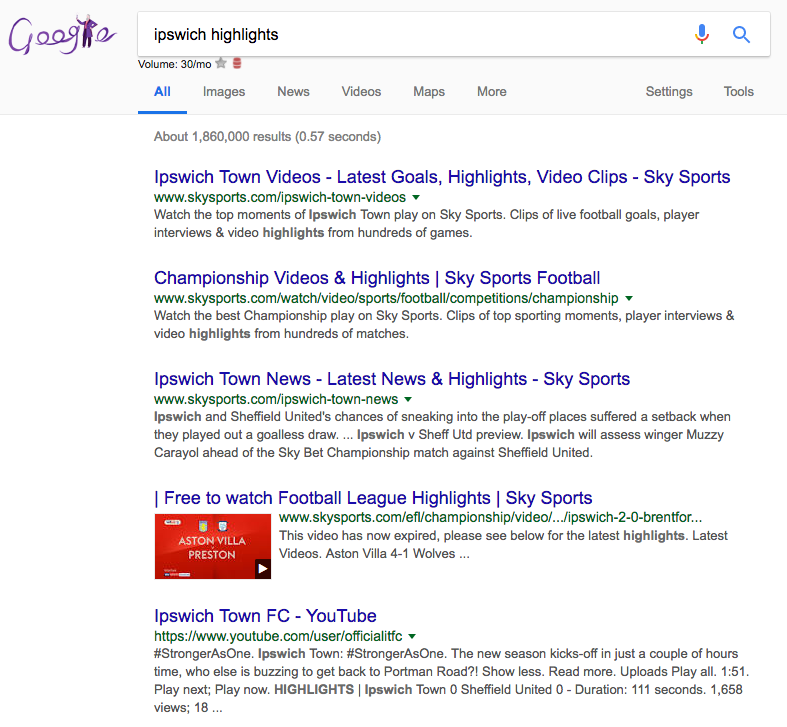
The video snippet box is the obvious and most touted potential benefit of using video schema, but what I’d like to question is the data options you can provide for video schema – the transcript specifically.
When it comes to almost all schema, there are required elements (such as “name” or “image”) that have to be in place, or Google will report an error with your markup. On top of this, there are recommended or additional elements (such as “sameas” or “hasmap”) that you can add if you wish to provide more information, but your markup will still work without them. The general consensus I see in the industry, and I also subscribe to, is the more information you can add, the more likely your site will be rewarded for the use of structured data.
This is where my curiosity recently tweaked. Why exactly are people working in SEO saying this? Google has stated structured data is not a way to improve your rankings (although some case studies have questioned this). Truthfully, I haven’t seen any research/tests to prove this notion that adding more information to your schema has direct ranking benefits.
“Google doesn’t use markup for ranking purposes at this time—but rich snippets can make your web pages appear more prominently in search results, so you may see an increase in traffic.”
Video is one of the core areas I feel we have fallen blindly to this. I’ve written and implemented many pieces of video schema over the years. Almost every time, I’ve advised a transcript itemprop is added, so Google can better understand the content of the video – that is, based on the assumption it may serve as additional content on the page, therefore improving copy depth and rankings in response.
Although transcripts haven’t been a huge investment for any of the projects I’ve personally worked on, I can see how the time/resource needed to create them could add up into huge figures on sites that heavily rely on video. If I were faced with a website that had 50+ unique videos, all 3 minutes long a piece, would I be comfortable telling the site owners they 100% need to transcribe those videos to get maximum value from them in organic search results?
Pondering on this, I decided to run some tests. I’ve summarised the results in a TL;DR format at the end of this post if you are in a rush and wish to scroll all the way down. Otherwise, please read on.
Hypothesis and Method
The theory for this test was quite simple:
If I add a video with a transcript within the schema to a page, and that markup is of benefit to rankings, I’d be able to shift the needle on some very low competitive keywords.
My prediction was not a hopeful one, seeing as I’d already tried searching some video transcript copy on existing client sites in quotation marks, which ended up in zero results on Google. This suggested that Google doesn’t index transcripts within structured data in the same way it indexes visible on-page content.
For this experiment, I went to my usual playground where I run these tests; my personal blog domain. I also gained assistance from our Video Production Specialist, Sam Gale, who gave me ten minutes of his time to record me rambling in front of the camera. I then embedded on the homepage of my site on 12 March 2018.
I decided to target 3 keywords…
- “Dan Callis” – mildly competitive term; I currently rank #4 (there are a few Dan Callis’ out there)
- “Elasticated Vegan Chess Pieces” – made up keyword; only 6 results in Google search results that my site did not appear for
- “Bouncy Concrete Tofu Steak” – made up keyword; tiny pool of results that my site did not appear with
The first two keywords were targeted within the video and transcript itself, while the third was not going to be mentioned anywhere but in the markup description. The markup was created, published via Google Tag Manager and all working on the same day the video was added to my homepage.
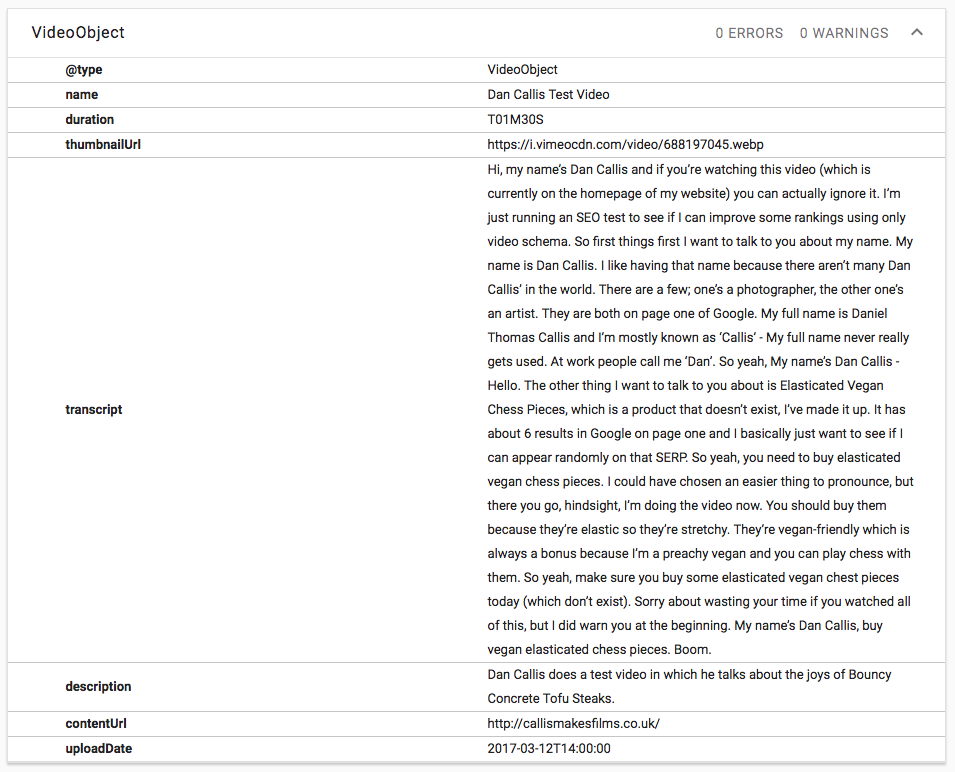
I also did a Fetch as Google and index request in Search Console to ensure the changes were honoured as soon as possible.
Research Findings
It wasn’t until 22 March, that the VideoObject started to appear in the Structured Data tab of Google Search Console, although the “Last Detected” column stated it had acknowledged the existence of the markup as of 18 March at the latest.
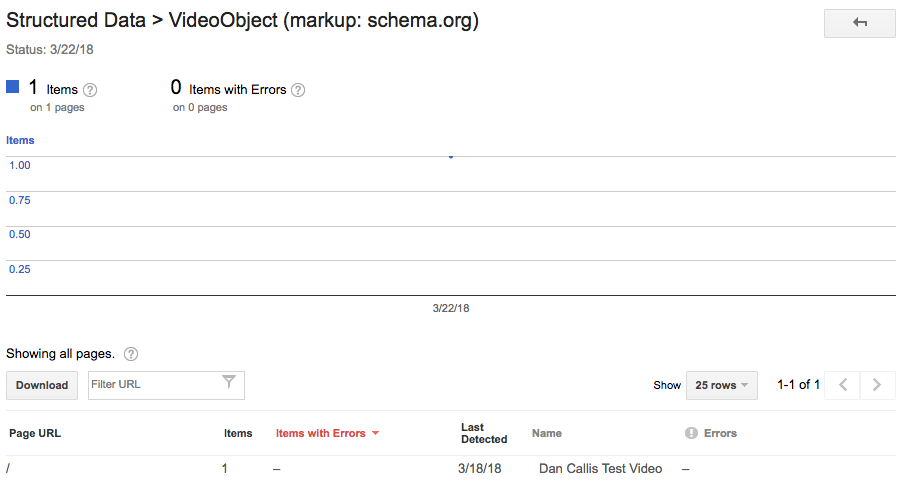
Almost a month later by 16 April, I didn’t see any video snippets appearing in Google’s standard or video results for my name, nor was my site appearing for the two random keywords. I had seen a slight increase in ranking for my name from #4 to #3, but I couldn’t be certain that this was a result of the video schema, due to the fact that Google was not honouring it by showing it in search results. To really determine if the transcript was enough to influence rankings, I had to be sure Google was willing to display the video snippet for the main targeted term at the very least.
Following this, I decided to create a unique page for the video using a more keyword more specifically related to my name as an additional experiment. On the same day, I added the page https://callismakesfilms.co.uk/dan-callis-itfc-supporter to my site and embedded the video, whilst simultaneously removing the video from the homepage. I changed the video title in the JSON to be “Dan Callis ITFC supporter” too, with the theory being perhaps a deeper page with more granular keyword targeting, would be more likely to be picked up as a video rich snippet than just my name on the homepage of my site.
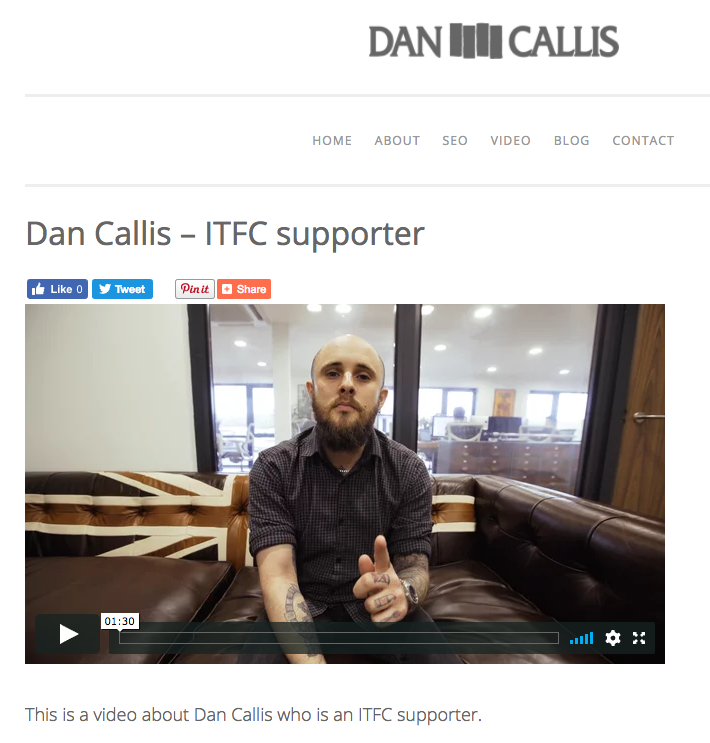
On 1 May, the video started to show up in the SERPs under ‘Video’ results for the revised target phrase. This, as common sense on Google’s side, would suggest, implies that it may only show a video snippet if the video is relevant to the page content. Although this wasn’t specifically what I set out to test, I felt this was worth noting nonetheless.
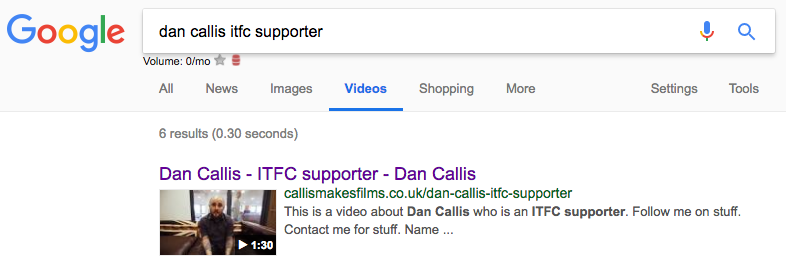
However, that same day, I still wasn’t seeing the page or the video in the SERPs for the two more obscure targeted keywords. Since the video had literally just started showing up that afternoon (I had manually checked twice that day), I decided I give it at least a week longer before jumping to any conclusions. Rolling up to 10 May, again, I still wasn’t seeing anything for either.


The conclusion from this experiment suggests that Google’s official statement rings true when it speaks about the benefits of structured data and video – a transcript alone may not have any direct impact on specific rankings.
While the experiment had proven video transcripts may not be worth the extra effort for structured data, it goes without saying that putting said content on the page in visible form for the user to read could have ranking benefits (long-form content, higher copy depth, more keyword targeting on a page, etc).
Yet, I can guarantee almost every client I’ve ever worked with would understandably object to throwing a transcript on an important converting page for UX and design reasons. Of Course, there are some cases where a published transcript does absolutely benefit the user, a good example being the Moz Whiteboard Friday posts, I’ll often skim read if I’m limited on time.
Due to this, I decided to follow up with another test and add the transcript copy to the page, so it is visible to users, BUT only when the user clicks a drop down accordion menu to choose to read it. There has been much debate about how Google treats (and therefore rewards) content that is “hidden” from users in the form of drop-down or tabbed menus, but I personally haven’t encountered a problem in this area (I’d hope that’s because I’ve only ever used dropdowns in a user/design-friendly manner). I have spoken to people in the past who claimed to have seen issues in this area, but I can’t speak for every website/SEO in the world by saying it will never cause a problem as there are too many factors to consider. Still, Google’s official line on the subject says nothing about content the user has to access via a second click.
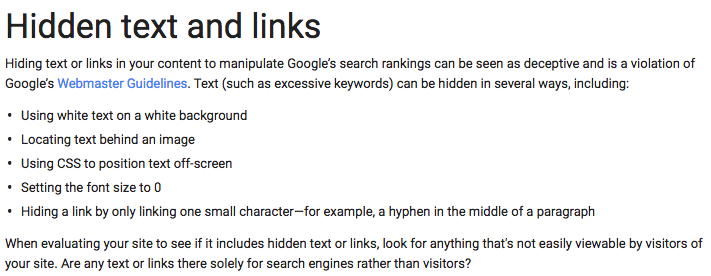
I added an accordion containing the transcript copy to the page and did a ‘Fetch As Google’ in GSC to get the page crawled again as soon as possible.
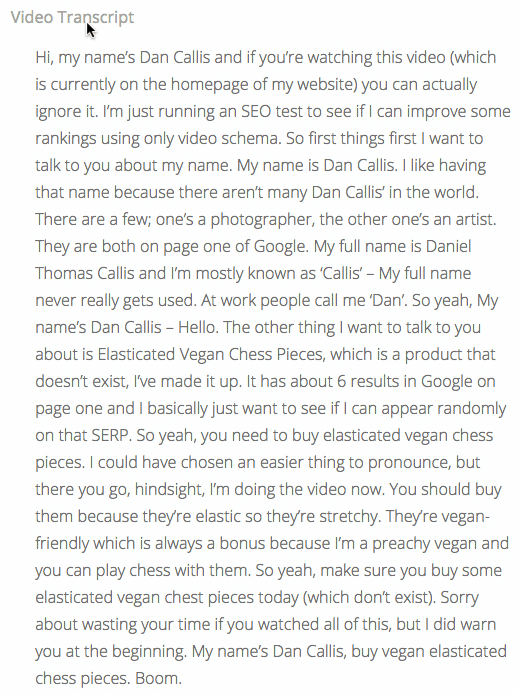
Lo and behold, almost instantly, I’d started appearing in the results for “elasticated vegan chess pieces” with a video snippet.
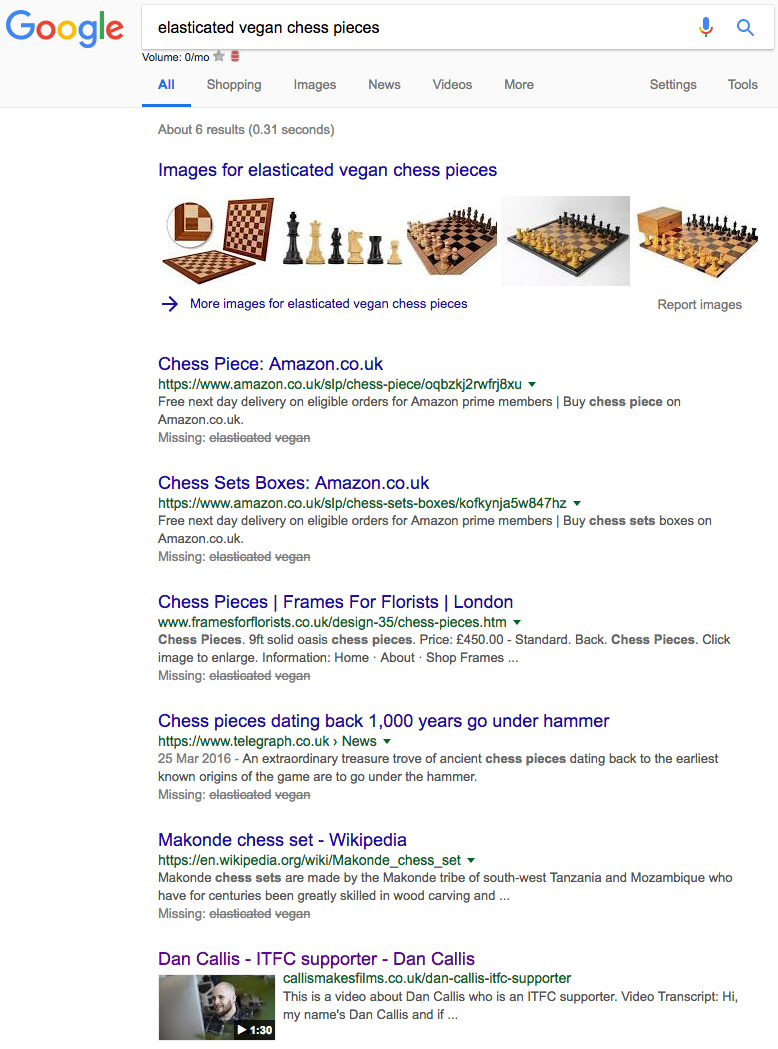
Caveats
As per every SEO experiment I do, I always like to clarify that I am not drawing up my conclusion as an out-and-out “THIS IS HOW IT WORKS AND THIS IS WHAT YOU SHOULD DO” statement.
- The sample size for testing is a single website, two pages, one video and three low competition keywords.
- How such an experiment would pan out on a wider sample size and/or in a competitive environment could be completely different based on multiple factors (including implementation methods).
My aim here is simply to challenge how we think about things in regards to video schema and open up a discussion. If anyone decides to run this test on more websites or in an actual competitive SERP niche for a business I’d love to see the results.
The other caveat I would like to raise, is I have not run this experiment using a video format that includes a subtitled transcript within the video itself. The results of this may change if you were to say use Youtube (which Google owns and may, therefore, be able to trust transcripts more reliably than what schema alone tells it). The downside of Youtube is while hosting your videos, it often results in Youtube’s page ranking above the page on your site where the video is embedded, which often contradicts the point in doing video for SEO benefits in the first place and why I’ve not factored it into this experiment.
Conclusion
Running this test led me to the conclusion that:
Although video structured data is of value to achieve rich snippets in search results (which we all already know), video transcripts as part of a schema in isolation may not impact your organic performance in any way.
If you are going to go through the extra time/effort/cost to transcribe your videos, it’s worth adding the said transcript to the page itself, so Google treats it as any other content on your website and indexes it, which in turn could be beneficial to rankings.
What’s the best way to do this that’s user-friendly and doesn’t add a huge bulk of the text to a page built for CTA? My best suggestion off the top of my head is to add a “Video Transcript For Hard of Hearing” button near your videos that present the transcript copy in a readable (and crawlable/indexable) format. In this way, you’ll get the potential benefit of both the video snippet and the content itself.
TL;DR
- Using a transcript in structured data alone will not give you any ranking benefits and Google does not treat it in the same way it does on-page content
- This does not mean video structured data is waste of time – as we already know, using it may result in video rich snippets in search results which are great for improved click-through rates.
- If you add the transcript copy to your page and indexable and crawlable content, you may see ranking benefits.
- My personal suggestion to do this is to add a “Video Transcript for Hard of Hearing” button around your videos to present the content in a way that is still user-friendly and doesn’t affect the page layout.
- This test does not consider how Youtube transcripts are processed by Google, which may be completely different.
If you have any questions about this experiment or want to share your own findings/data, I’d love to hear from you. Please send me a tweet at @callis1987. Cheers!
Piece originally written by Daniel Callis.















